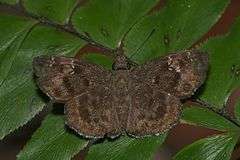Sarangesa dasahara
| Common small flat | |
|---|---|
 | |
| Scientific classification | |
| Kingdom: | Animalia |
| Phylum: | Arthropoda |
| Class: | Insecta |
| Order: | Lepidoptera |
| Family: | Hesperiidae |
| Genus: | Sarangesa |
| Species: | S. dasahara |
| Binomial name | |
| Sarangesa dasahara (Moore, 1865)[1] | |
| Synonyms | |
| |
Sarangesa dasahara, the common small flat, is a butterfly belonging to the family Hesperiidae.
Field characteristics

The common small flat has a wingspan or around 30–35 mm. It is a dull black or brown butterfly with a semi-transparent spot on the wings and sometimes with no visible spots. The underside of the wings is grey brown with diffused dark spots. The male and female are similar in shape and colour and with hardly any differentiation. Both sexes of the flat are similar in appearance, being dull brownish black above and greyer in colour below. The butterflies have small, semi-transparent discal, cell and apical spots. The dark spots on the underside of the forewing are large, dark and diffused.[2]
Status, distribution and habitat
This species is most commonly visible at the end of the rainy season, but sparsely found in the post-monsoon months. It is common but not abundant in most habitats. The spotted small flat (Sarangesa purendra), though, is more common in the arid regions. It occurs in openings and edges in both the evergreen and semi-evergreen forests, deciduous forests, and scrub & short grassland savannahs. It is found in the Deccan plains and also in the hills, but more frequently found at lower elevations. Except for the very dry north-west India, it occurs commonly throughout the country, in Sri Lanka and in the Indo-Chinese region.[2]
Habits
The butterfly though tiny, flies extraordinarily fast but in an erratic and jerky fashion. Though the flight seems jerky and erratic, the butterfly lands smoothly on the substratum, and that too suddenly. It fight is always close to the ground and has the habit of sometimes returning to the same spot for perching.
It feeds on flowers of herbs and small bushes and also rarely on birds' droppings and wet rocks for minerals. It always keeps its wings spread. It almost always rests on the underside of leaves, but basks on the upperside with its wings fully spread.[2]
Larval host plants
Its larval host plants are Acanthaceae herbs and small shrubs; Asystasia species and Blepharis asperrima. These species grow in neglected places around human habitations, in deciduous forests and openings in evergreen forests.[2]
Subspecies
- Sarangesa dasahara dasahara (north-western Himalaya to Burma, Vietnam, Laos, Thailand, southern Yunnan)
- Sarangesa dasahara albicilia Moore, [1881] (Sri Lanka)
- Sarangesa dasahara davidsoni Swinhoe, 1912 (India: Maharashtra)
Gallery
_at_Samsing%2C_Duars%2C_West_Bengal_W_IMG_6137.jpg)
 In Maharashtra, India
In Maharashtra, India
Cited references
- ↑ Sarangesa, funet.fi
- 1 2 3 4 Kunte, Krushnamegh (2000). Butterflies of Peninsular India. India, A Lifescape. Hyderabad, India: Universities Press. pp. 202–203, ser no 67. ISBN 978-8173713545. (under Common Small Flat Sarangesa dasahara Moore).
See also
References
- Kunte, Krushnamegh (2000). Butterflies of Peninsular India. India, A Lifescape. Hyderabad, India: Universities Press. ISBN 978-8173713545.